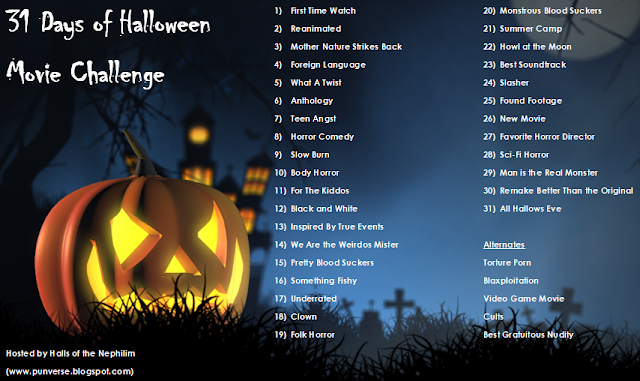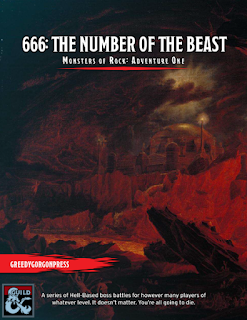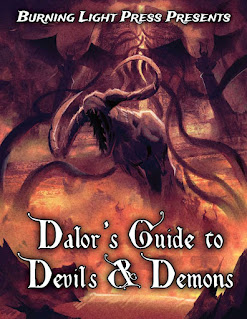The Other OSR: A Waning Light
 There is a realm that lies between the land and the sea that is neither land nor sea. It is said that this is where the giants died, their blood spilling as a gift that turned the realm into something in between, a land of peat and oil and mud that languorously discharges into the Endless Sea. This is Fattvëlland, the Great Slick, beyond Targ-Dungel and the festering swamps of the Rotlands, and here no flame burns except that which cannot die and burns constant below the peat and the oil and the mud. The Great Wick drinks of the land and gives birth to shunned and raging Wickheads, trimming them before sending unwanted and unloved out into the lands on the other side of Targ-Dungel and the Rotlands. Their purpose unknown to themselves and the Great Wick, no Wickhead has ever returned—or seemed to want to. Until now. This is the set-up for A Waning Light, a scenario for use with Mörk Borg, the Swedish pre-apocalypse Old School Renaissance retroclone designed by Ockult Örtmästare Games and Stockholm Kartell and published by Free League Publishing.
There is a realm that lies between the land and the sea that is neither land nor sea. It is said that this is where the giants died, their blood spilling as a gift that turned the realm into something in between, a land of peat and oil and mud that languorously discharges into the Endless Sea. This is Fattvëlland, the Great Slick, beyond Targ-Dungel and the festering swamps of the Rotlands, and here no flame burns except that which cannot die and burns constant below the peat and the oil and the mud. The Great Wick drinks of the land and gives birth to shunned and raging Wickheads, trimming them before sending unwanted and unloved out into the lands on the other side of Targ-Dungel and the Rotlands. Their purpose unknown to themselves and the Great Wick, no Wickhead has ever returned—or seemed to want to. Until now. This is the set-up for A Waning Light, a scenario for use with Mörk Borg, the Swedish pre-apocalypse Old School Renaissance retroclone designed by Ockult Örtmästare Games and Stockholm Kartell and published by Free League Publishing.A Waning Light is best described as a ‘swamp crawl’ in which the Player Characters are hired by a Wickhead called Lygan, whose wick is growing short and who wishes to return to his point of origin before the God Tree and pluck a new thread and thus wick from it. He promises them riches and a sight which no mortal man has seen before. Adding A Waning Light to an on-going campaign is relatively easy. Its location can be slid onto any coast and in addition, there are suggestions which tie various other scenarios for Mörk Borg to the Great Slick. These are Rotback Sludge, Treasures of the Troll King, and Putrescence Regnant and all three come with helpful notes on how to make the connections. A table of rumours serves as other means to spur the Player Characters to action.
Published by Loot the Room, it presents a sludge-ridden region where geysers of oil blot the sky, goblins scavenge on long stilts, baleful balls of light whisper secrets, and tar oozes blend below the oil slicked water ready to strike at the unwary. There are strange henges to be found, their stones cracked by black ivy, a colony of mournful goblins who have turned their backs on their wild and dangerous days, and an ancient dragon, Nithul, her brittle bones turned silver with age and her wings pinned to the mound of silver she sits on by foot-long iron spikes. Her only company is the calcified statue of the knight who was trying to kill her, his sword still held high, and she is half mad with loneliness. These encounters are fantastically forlorn, fitting the sombre, even woeful nature of the land. The heart of the adventure lies in its two dungeons—‘Inside Julud’ and ‘The Sink’.
The first and smaller of the two is ‘Inside Julud’. Located within the skull of a dead giant, this is a mini-dungeon consisting of fourteen locations across two levels, the lower level, either partially or wholly flooded. There is constant movement within the flooded and submerged rooms below, primarily of water and natural gas, and this is decidedly hazardous environment. Unfortunately, there is really very little reason to explore its rooms beyond greed and curiosity and given its nature it may be one that the Player Characters readily avoid all together. Perhaps a rumour or hook or too might have pushed the Player Characters to the location beyond mere chance—and perhaps the Game Master might want to develop one or two herself. Finally, despite being in the head of a giant, ‘Inside Julud’ does not feel like it is.
The second and much longer of the two dungeons is ‘The Sink’. Here the Player Characters may eventually discover the God Tree and Lygan find a way to replace his wick so that his memories need not be lost. A mixture of worked rooms and caverns, it is double the size of the ‘Inside Julud’, full of soot, oily vapours, ancient industrial machinery still covered in thick grease and dirty lubricant, and a dampness that pours in from the swamp above. Despite being a ruin, the cult operating here lends the place a sense of purpose, even if the main NPC here, the leader of the Moth cultists, is underwritten inn terms of motivations and reactions, especially in light of the attention given to the prophetic, Three Flames, the past, present, and future Voice of the Flame, the burning equivalent of the three witches from Macbeth or the Graeae from Greek Mythology. Again, this is something that the Game Master might like to develop herself.
Physically, A Waning Light is not as terse as perhaps other scenarios and dungeons are for Mörk Borg and there is a lot more description than you would normally expect. All locations are marked easily—though not always accurately in some cases—on the map, which appears on each page of the dungeon for easy navigation by the Game Master. The writing is clear and in general, presented in a bolder fashion than other scenarios for Mörk Borg. In places, the Game Master is left to wonder who or what something is until the book explains it.
A Waning Light is in need of a few hooks to get the Player Characters to explore some of the locations in the swamp and the Game Master may also want to develop the motivations of the NPCs further, as well. Fix those and A Waning Light will provide the means to explore the origins of the Wickheads from Mörk Borg, memorably set across a festering, oily sludge of a swamp, full of of mournful and scarred locations and encounters.



















.jpg)




